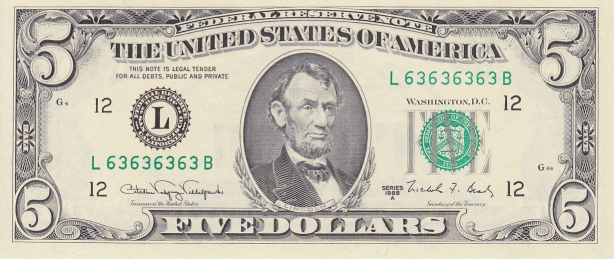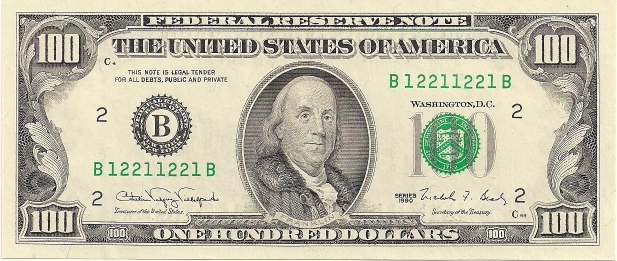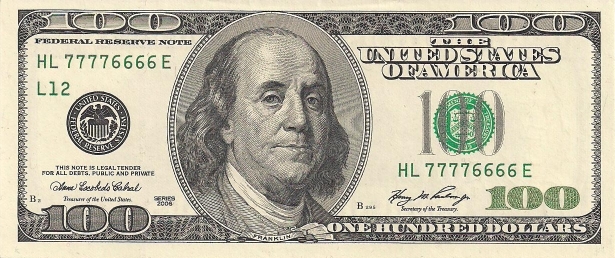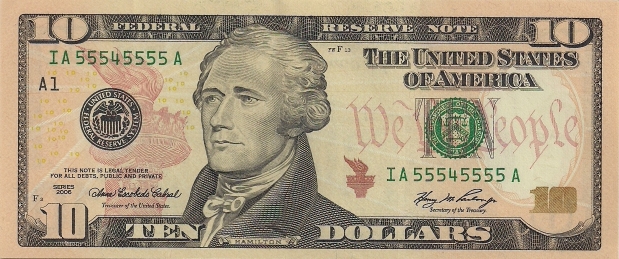Dollar notes with fancy serial numbers command a premium from some currency collectors. A solid serial number, a radar, a ladder, or several other types of fancy serial numbers can make a note worth much more than other notes with the same denomination, from the same series, and in the same condition. But just how rare are these fancy serial numbers? Dave Undis, a numismatist himself, sought out the answer and published it in an article in the journal Paper Money in 2011.
Modern United States currency features eight-digit serial numbers from 00000001 to 99999999. There are 99 999 999 different eight-digit serial numbers. To keep things simple, we'll assume that all serial numbers are equally likely to appear on a randomly selected note. In reality, some serial numbers are harder to find because the Bureau of Engraving and Printing1 usually removes them from production before circulation, replacing them with star notes2. Also, print runs don't always start at 00000001 or go all the way up to 99999999. But this doesn't really affect our analysis much. (To make some of the arithmetic below simpler, we'll sometimes include the non-existent 00000000 serial number, making a total of 100 000 000 serial numbers, but we'll always remember to remove that non-existent note from our totals.)
In a solid serial number, every digit is the same. There are nine solid serial numbers: 11111111, 22222222, 33333333, 44444444, 55555555, 66666666, 77777777, 88888888 and 999999999.

In a ladder serial number, each digit is one number higher (or lower) than the previous digit. There are six eight-digit ladder serial numbers: 01234567, 12345678, 23456789, 76543210, 87654321 and 987654321. (There are eight if you also count 34567890 and 09876543.)

In a radar serial number, the second four digits are the reverse of the first four digits. Examples are 11188111 and 20066002.

In a repeater serial number, the second four digits are a repeat of the first four digits. Examples are 11181118 and 20062006.

In calculating the number of radars and repeaters, it's useful to divide the eight-digit serial number into its first and second halves. Consider the first half. There are 10 000 possible numbers: 0000 through 9999. Now consider the second half. Again, there are 10 000 possible numbers. Of these 10 000, only one will be the same as the first half and only one will be the reverse of the first half. So there are 10 000 repeaters and 10 000 radars. These totals include the non-existent 00000000 number and the nine solids. Excluding these, there are 9 990 radars and 9 990 repeaters.
A super radar is a special kind of radar. A super radar is a radar in which the middle six digits are all the same. Examples are 71111117 and 98888889. There are 99 super radars: 01111110, 02222220, 03333330, …, 97777779, 98888889 and 99999999. Nine of these are solids. Excluding these, there are 90 super radars.

A super repeater is a special kind of repeater. A super repeater is a repeater in which the first two digits are repeated four times. Examples are 26262626 and 78787878. There are 99 super repeaters: 01010101, 02020202, 03030303, …, 97979797, 98989898 and 99999999. Nine of these are solids. Excluding these, there are 90 super repeaters.

A radar repeater is both a radar and a repeater. Examples are 26622662 and 87788778. There are 99 radar repeaters: 01100110, 02200220, 03300330, …, 97799779, 98899889 and 99999999. Nine of these are solids. Excluding these, there are 90 radar repeaters.

In a double quad serial number, the first four digits are all the same and the last four digits are all the same, but a different number. Examples are 11114444 and 22226666. There are 99 double quads: 00001111, 00002222, 00003333, …, 99997777, 99998888 and 99999999. Nine of these are solids. Excluding these, there are 90 double quads.

In a seven-in-a-row serial number, seven digits in a row are all the same. Examples are 11111112 and 35555555. For each of the nine solid serial numbers, you can make 18 seven-in-a-row serial numbers: nine by changing the first digit and nine by changing the last digit. For example, these are the nine seven-in-a-row serial numbers you can make by changing the first digit of solid serial number 99999999: 09999999, 19999999, 29999999, 39999999, 49999999, 59999999, 69999999, 79999999 and 89999999. You can also make 18 seven-in-a-row serial numbers by changing the first or last digit of the non-existent 00000000 serial number. So there are 180 seven-in-a-row notes.

In a seven-of-a-kind serial number, seven of the digits are all the same. Examples are 44444424 and 99899999. For each of the nine solid serial numbers, you can make 72 seven-of-a-kind serial numbers: nine by changing each of the eight digits. You can also make 72 seven-of-a-kind serial numbers by changing each of the eight digits of the non-existent 00000000 serial number. So there are 720 seven-of-a-kind notes. This includes the 180 seven-in-a-row notes.

In a binary serial number, only two numbers appear in the eight digits. Examples are 10100111 and 11181888. To see how many binary serial numbers there are, pick two different numbers from zero through nine. 20% of all serial numbers have one of these numbers as the first digit. Of these, 20% have one of these two numbers as the second digit. Of these, 20% have one of these numbers as the third digit. Continue similarly through the eighth digit, So \[20\% \times 20\% \times 20\% \times 20\% \times 20\% \times 20\% \times 20\% \times 20\%\] of all serial numbers have one of these two numbers for all eight digits. That's 256 serial numbers. Two of these 256 serial numbers are solids, leaving 254. There are 45 different ways to choose two different numbers from zero to nine. Multiplying 254 by 45 tells us there are 11 430 binary serial numbers (excluding solids).

The table below shows how many different fancy serial numbers appear in a run of 99 999 999 nites. It also shows the odds of seeing each type of fancy serial number on a randomly selected note from a run of 99 999 999 consecutive notes.
| fancy serial number type | number of occurrences | odds |
|---|---|---|
| solid | 9 | 1 in 11 111 111 |
| ladder | 6 | 1 in 16 666 667 |
| radar | 9 990 | 1 in 10 010 |
| repeater | 9 990 | 1 in 10 010 |
| super radar | 90 | 1 in 1 111 111 |
| super repeater | 90 | 1 in 1 111 111 |
| radar repeater | 90 | 1 in 1 111 111 |
| double quad | 90 | 1 in 1 111 111 |
| seven-in-a-row | 180 | 1 in 555 556 |
| seven-of-a-kind | 720 | 1 in 138 889 |
| binary | 11 430 | 1 in 8 749 |
As previously mentioned, a random note will typically not come from a run of 99 999 999 notes. But this table still gives a good starting point for further analysis and collecting enjoyment.
Assignment
We represent a serial number either as a strictly positive natural number (int) or as a string (str) that exists of one or more digits that are not all equal to zero. The number of digits in a serial number is not fixed, but there's always at least one digit. In converting a serial number into its string representation (str), leading zeros are added until the string representation has at least eight digits. Your task:
-
Write a function serial_number that takes a serial number (int or str). The function must return the string representation of the serial number (str). If the serial number has less than eight digits, leading zeros must be added to its string representation, so that it has eight digits in total.
-
Write a function solid that takes a serial number (int or str). The function must return a Boolean value (bool) that indicates whether the serial number is a solid, i.e. all digits in the string representation of the serial number are the same.
-
Write a function radar that takes a serial number (int or str). The function must return a Boolean value (bool) that indicates whether the serial number is a radar, i.e. the string representation of the serial number reads the same from left to right as from right to left. By definition, however, solids are never radars.
-
Write a function repeater that takes a serial number (int or str). The function must return a Boolean value (bool) that indicates whether the serial number is a repeater, i.e. the first and the second half of the string representation of the serial number are the same. By definition, however, solids are never repeaters.
-
Write a function radar_repeater that takes a serial number (int or str). The function must return a Boolean value (bool) that indicates whether the serial number is a radar repeater, i.e. both a radar and a repeater.
-
Write a function numismatist that takes a sequence (list or tuple) of serial numbers (int or str). The function must return a new list containing the serial numbers from the given sequence that belong to some kind. By default we are looking for solids, but the function numismatist also has a second optional parameter kind. This parameter may take a function that itself takes a serial number (int or str) and returns a Boolean value (bool) that indicates whether the given serial number belongs to the kind we are looking for.
All these function must raise an AssertionError with the message invalid serial number if an argument is passed that is not a valid serial number.
Example
>>> serial_number(834783)
'00834783'
>>> serial_number('47839')
'00047839'
>>> serial_number(834783244839184)
'834783244839184'
>>> serial_number('4783926132432*')
Traceback (most recent call last):
AssertionError: invalid serial number
>>> solid(44444444)
True
>>> solid('44544444')
False
>>> radar(1133110)
True
>>> radar('83289439')
False
>>> repeater(20012001)
True
>>> repeater('83289439')
False
>>> radar_repeater('12211221')
True
>>> radar_repeater('83289439')
False
>>> numismatist([33333333, 1133110, '77777777', '12211221'])
[33333333, '77777777']
>>> numismatist([33333333, 1133110, '77777777', '12211221'], radar)
[1133110, '12211221']
>>> numismatist([33333333, 1133110, '77777777', '12211221'], kind=repeater)
['12211221']